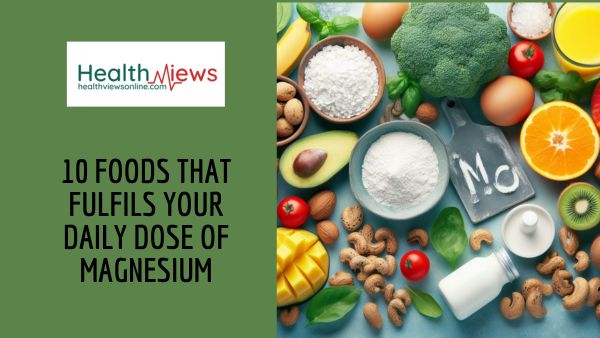Magnesium is an important micronutrient that is required for various bodily activities. This vitamin is essential for bone health, calcium absorption, dietary metabolism, fatty acid and protein synthesis, and nerve function.
It occurs in hundreds of chemical reactions in your body and helps in the maintenance of good health, although many individuals do not meet the Daily Value (DV) of 420 milligrams (mg). Source
Also, Read Health Benefits Of Whey Protein: Nutrients, Nutrition, Healthy Facts
1. Dark chocolate
Dark chocolate is one of the most delectable methods to meet your body’s magnesium requirements. A 28-gram (1-ounce) Dark chocolate bar has around 65 milligrams of magnesium. Apart from that, dark chocolate is high in other nutrients such as manganese, iron, copper, and prebiotic fibers, which aid in the battle against germs in the body. Source
However, eating too much dark chocolate might raise your caffeine levels, causing your heart rate to rise.
Also, Watch health views web stories: 8 FOODS THAT FULFILL YOUR VITAMIN C DOSE
2. Avocados
Avocados are a delicious and nutrient-dense fruit that is high in it. The average avocado fruit contains approximately 58 mg of magnesium, which can satisfy approximately 14% of your daily magnesium requirement. Source
It is also high in nutrients such as vitamin K, potassium, vitamin B, and mono-saturated fats, all of which are beneficial to heart health. Avocados are also a good source of fibre, that helps in digestion.
3. Nuts
Almost all nuts are healthy for the human body in many ways, but cashews, Brazil nuts, and almonds are the best due to their high magnesium concentration. An ounce of cashews has more than 80 milligrams of magnesium, which accounts for about 20% of your daily magnesium needs. Source
Nuts are high in monounsaturated fats, which aid with blood sugar regulation and cholesterol control. Nuts are ready-to-eat foods that can be eaten as a snack.
Also, Read Everything You Wanted To Know About Zinc!!!
4. Legumes
Legumes are one nutrient-dense meal that can help you reach your daily magnesium requirements. Beans, chickpeas, soybeans, and peas are examples of common legume food items. For example, A 1-cup (172 g) portion of cooked black beans contains 120 mg of magnesium or 29% of the daily value. Source
The high iron and protein content keeps you energized, and the high fiber content minimizes the risk of heart attacks and helps control blood sugar levels.
5. Tofu
Tofu is a type of processed cheese block created from condensed soy milk that is popular in China. If you’re a vegetarian, it’s strong in magnesium and a good source of protein. Tofu contains around 35 mg of magnesium per 100 g which is 8% of the DV. Source
Tofu includes about 10 grams of protein per serving, as well as other important elements including iron, manganese, calcium, and selenium.
6. Seeds
Chia seeds, flax seeds, and pumpkin seeds are among the magnesium-rich seeds available on the market. Pumpkin seeds are one of the greatest sources of it, with a single serving (28 gm) containing 168 mg of magnesium, which accounts for around 40% of your daily requirement. Source
It’s also strong in mono-saturated fats, omega-3 fatty acids, antioxidants, and fiber, all of which help keep your heart healthy and your metabolism running smoothly.
7. Whole grains
Whole grains including wheat, barley, and oats are high in fiber and magnesium. A cup of wheat has about 86 mg of magnesium, which accounts for about one-fifth (20%) of your daily magnesium needs. Source
Whole grains are anti-inflammatory foods high in B vitamins, selenium, fiber, and manganese. It lowers the risk of heart disease and fights inflammation.
8. Fatty fish
Fish is a good source of protein, but some fatty fish, such as salmon, halibut, and mackerel, are also high in magnesium. One dish (100 grams) of cooked salmon contains around 30 milligrams of magnesium, which accounts for 7% of the daily value. Source
A high fatty fish intake has been related to a lower risk of various chronic illnesses, including heart disease. These advantages have been related to high levels of omega-3 fatty acids.
9. Bananas
Bananas are one of the most widely available and nutritious protein-rich fruits. It’s high in potassium and has been shown to help reduce the risk of heart disease. Apart from potassium, bananas are also high in magnesium, with one large banana providing around 37 mg of magnesium, or 9% of the DV. Source
Therefore, including bananas in your diet can help you meet your daily it needs. Some bananas are heavy in sugar and carbs, so if you’re on a low-carb diet, you should avoid them.
10. Leafy greens
Leafy greens are extremely healthy, and many varieties are high in magnesium. Kale, spinach, collard greens, turnip greens, and mustard greens are examples of magnesium-rich leafy greens. A 1-cup (180-g) portion of cooked spinach, for example, contains 158 mg of magnesium, or 37% of the DV. Source
Leafy greens include a variety of beneficial plant components that help protect your cells from harm and may lower your risk of cancer.
There are numerous magnesium-rich foods to choose from, but it is critical to choose one that is conveniently accessible, can be included in your daily diet, and has no unwanted negative effects. Seeds, Avocados, nuts, legumes, and bananas are some of the best examples of such foods.
The best approach to achieve your daily magnesium need is to consume an adequate number of the foods listed above. Apart from magnesium, it is advisable to choose foods that contain additional minerals to help you stay fit and healthy.
Also, Watch health views web stories: 8 Foods That Fulfill Your Vitamin E Dose





